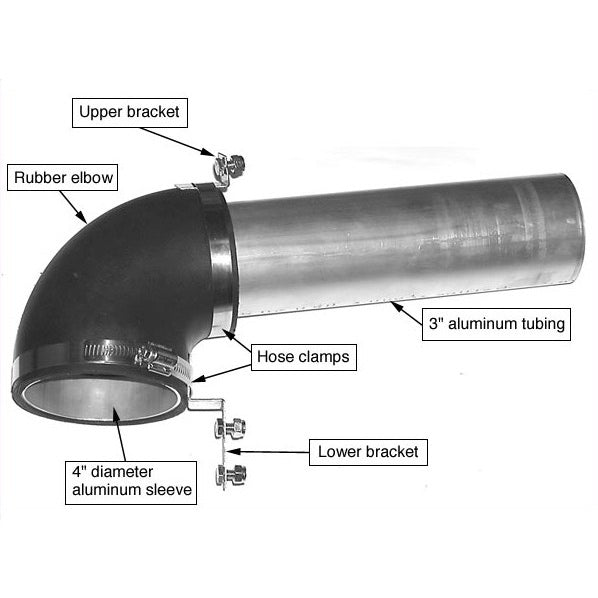JTR Stealth
High-Flow Cold-Air Intake for 2004, 2005 Chevrolet Colorado
High-Flow Cold-Air Intake for 2004, 2005 Chevrolet Colorado
Couldn't load pickup availability
Why You Might Want One.
On a stock Colorado, this kit provides about a 10 horsepower increase to the rear wheels.
The JTR/Stealth Conversion’s high-flow cold-air intake is a simple, effective, and low-cost way to improve power by providing cool, unrestricted, ram air to the Colorado air cleaner assembly. It fits both the 4-cylinder (2.8 liter) and 5-cylinder (3.5 liter) engines.
Quarter mile testing on a 2005 extended cab 2wd ZQ8 with the 5-cylinder engine/automatic transmission showed a 1.2 mph increase in trap speed, and a .2 second drop in ET.
0-60 mph times dropped by .2 seconds.
The rubber elbow mounted behind the grill prevents water intrusion into the intake system when the truck is driven in the rain, or when washed. The elbow also reduces intake noise slightly.
The high-flow cold-air intake requires cutting a 3" hole in the radiator support and a 3" hole in the air cleaner assembly.
Colorado Cold air kit parts list:
- Rubber elbow
- 4" linered hose clamp (linered hose clamps have an additional band of steel to protect the rubber from being cut by the slots used by the tightening screw)
- 3.5" linered hose clamp
- bracket, upper
- bracket, lower
- (3) 1/4-28 x 1/2" long bolts and lock nuts
- 4" diameter aluminum tube, 1.25" long
- 3" diameter aluminum tube, 10.25" long
- high-temp aluminum tape (not shown), to seal original snorkel
Colorado Intake comparison
Intake Snorkel Comparison
INTAKE SNORKELS AND COLD AIR
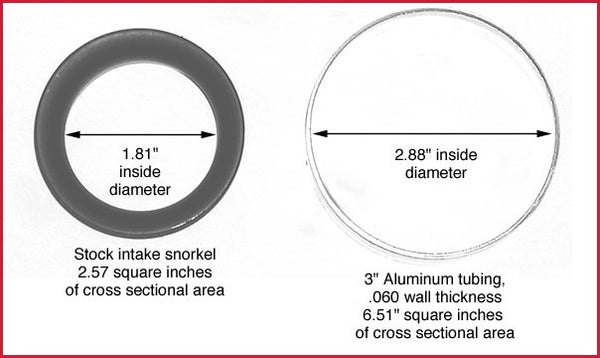
The stock intake snorkel on the Chevrolet Colorado is 1.81" on the inside diameter, and is the major restriction on the intake system. It gets its cold air supply from inside the fender. The reason Chevrolet uses the small snorkel is to reduce intake noise.
At high engine speeds on the 5-cylinder engine, the restriction of the stock snorkel causes a vacuum drop of about 1 psi, or about 7% of atmospheric pressure.
The JTR/Stealth Conversions high-flow cold-air intake eliminates the intake restriction by using a 3" intake tube which gets cold air from outside the engine compartment. On a 5-cylinder Colorado, the 3" diameter cold air intake is good for a 10 horsepower gain, compared to the stock intake snorkel, and it will not affect fuel economy.
The ram air effect of placing the intake in a high-pressure area in front of the truck also provides a very slight power gain at higher road speeds. At 60 mph, the ram air theoretically provides about a 1 horsepower increase, and at 85 mph, the ram air effect theoretically provides about a 2 horsepower increase.
STOCK RESONATOR
The stock resonator (the black plastic box on the top of the engine) is also designed to reduce intake noise, but it does not provide any measureable restriction. Replacing the resonator box with a straight piece of 7" long x 3-1/2" diameter aluminum tubing (and appropriate hose fittings for the crankcase ventilation and fuel pressure regulator), provides no measureable performance improvement in the 1/4 mile.
The flexible ducting from the air cleaner to the resonator is 3-1/2" diameter and provides no measurable restriction.
COLD AIR PERFORMANCE GAINS
Removing the stock snorkel from the air cleaner housing reduces the intake restriction, but then, hot air from the engine compartment gets into the air intake causing a loss of power, and a reduction in fuel economy.
Cold air intakes are very important for maximum performance and maintaining fuel economy. It is generally accepted that for every 10°F temperature drop of intake air, an engine will gain 1% more power. Under hood temperatures can be over 100°F higher than outside temperatures, so cold air can be good for a 10% power gain, compared to air filters which get hot air from the engine compartment.
Most of the aftermarket air filter kits for the Colorado get their air supply from inside the engine compartment. The aftermarket kits show a horsepower gain on a chassis dyno (with the hood open), but in real world conditions (with the hood shut and the engine fully warmed up), the hot air from the engine compartment reduces the power gains, and the fuel economy.
Most of the aftermarket air cleaner kits are very loud at full throttle, and many people believe the increased noise levels create more power, but the fact is, the aftermarket kits that get hot air from inside the engine compartment do not make as much power as the JTR/Stealth Conversions cold air intake.
Remove the grill from the truck. The grill is attached to the truck with clips. Remove the grill by pushing down the tabs on the upper clips, and then pulling firmly near each clip until the grill comes off.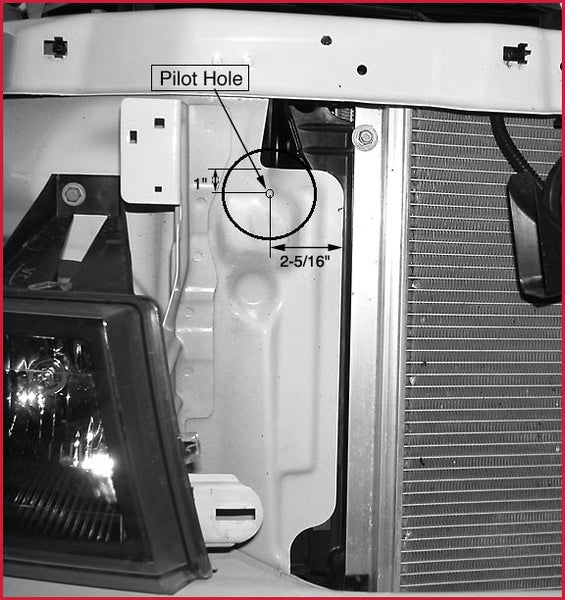 Disconnect the wires going to the lights, so the grill can be completely removed, and set aside. Mark the hole position as shown above.
Disconnect the wires going to the lights, so the grill can be completely removed, and set aside. Mark the hole position as shown above.
FRONT SHEET METAL MODIFICATION
Cut the sheet metal as shown above. Angle the hole towards the air cleaner housing.
It may be necessary to enlarge the hole slightly, with a file or die grinder, so the 3" aluminum tubing can easily pass through the cutout.
AIR CLEANER HOLE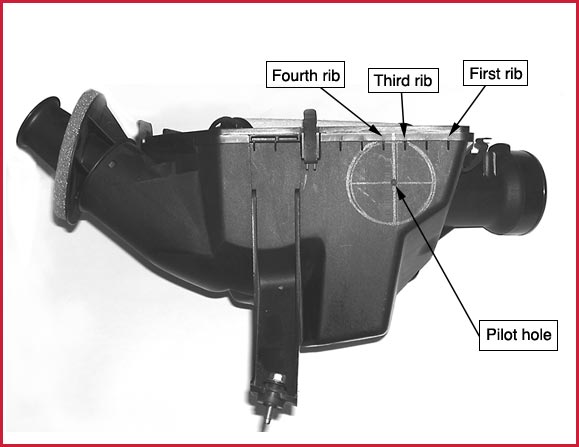
Cut a 3" hole into the air cleaner housing in the location shown above. The pilot hole should be midway between the third and fourth rib.
The hole needs to be "angled" so that the tubing fits into the air cleaner housing.
The easiest way to correctly "angle" the hole is to use a drill chuck extension, and cut the hole as shown below. A Milwaukee brand 5-1/2" long extension (part # 48-28-4001) is available at most hardware stores that carry Milwaukee brand hole saw, for about $20.
A drill chuck extension can be made by using a drill chuck (available at most hardware stores), and a 3/8"–24 x 6" long bolt (for a 3/8" capacity chuck), or a 1/2"–20 x 6" long bolt (for a 1/2" capacity chuck), which has the head cut off.
CUT A HOLE IN THE AIR CLEANER HOUSING

The easiest way to correctly "angle" the 3" hole into the air cleaner housing is to leave the air cleaner assembly installed in the truck, and use the cut-out in the front sheet metal as a guide.
Leave the air filter in place to prevent the plastic particles from entering the ducting going to the engine.
Use a very light pressure, and a moderately high speed to cut the hole, otherwise, the hole saw may "grab" the plastic housing.
If you cannot get a drill chuck extension, note the angle of the aluminum tubing going into the air cleaner housing on the following pages.
TEST FITTING ALUMINUM TUBING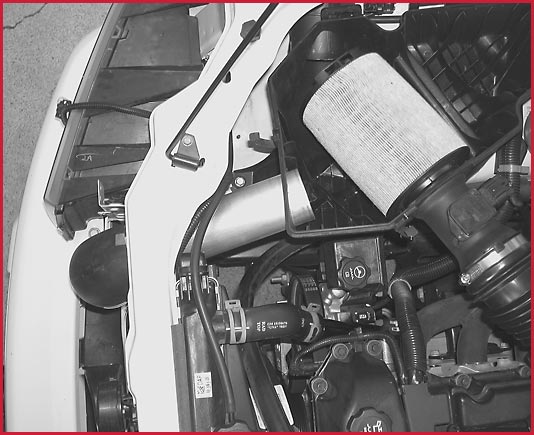
Test fit the aluminum tubing through the holes in the sheet metal, and the air cleaner housing.
Use a file or die grinder, as necessary, to enlarge the holes so the aluminum tubing can fit through the front sheet metal, and the air cleaner housing without binding.
SEALING THE STOCK SNORKEL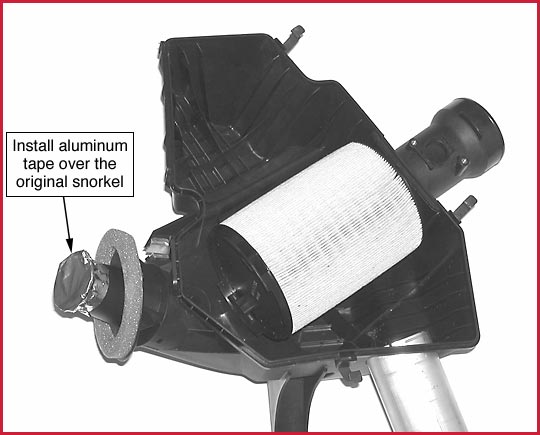
Remove the air cleaner housing from the truck. This requires a 13 mm socket to loosen the three bolts.
Install the supplied high-temp aluminum tape over the original snorkel, as shown, and reinstall the air cleaner housing into the truck. The purpose of sealing the stock snorkel is to allow the filter housing to become pressurized from the ram air.
FRONT ELBOW BRACKETS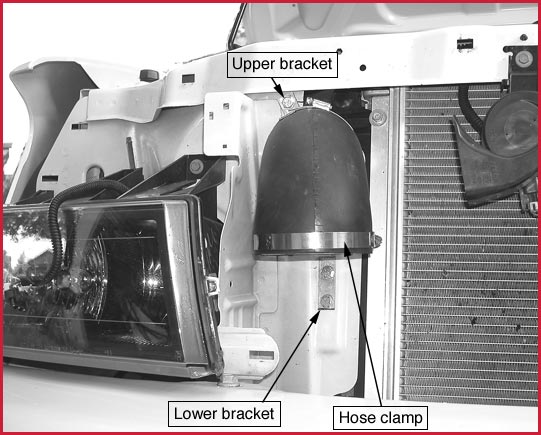
The rubber elbow is attached to the front sheet metal with the brackets shown.
First, install the brackets to the rubber elbow with the hose clamps.
Mark the position for the holes, and drill 9/32" holes into the sheet metal.
Fasten the brackets to the sheet metal with the supplied 1/4" nuts and bolts.
The elbow keeps water from entering the intake during rainstorms or when washing the truck. It also reduces intake noise at full throttle.
The elbow’s 4" inlet provides an unobstructed flow of air, and smoothly tapers down to the 3" aluminum tube.
The position of the elbow gets high-pressure ram air in the grill area, which provides a small amount of additional power at high speeds, approximately 0.5% at 60 mph, and about 1% at 85 mph.
We have not found any noticeable performance increase by removing the elbow, and strongly advise installing the elbow for maximum reliability.
Share
